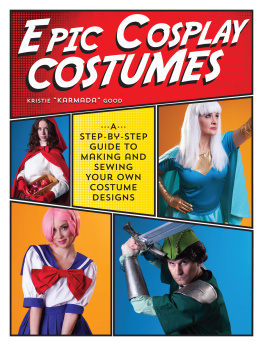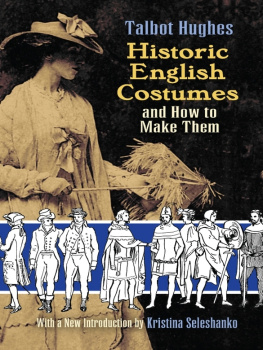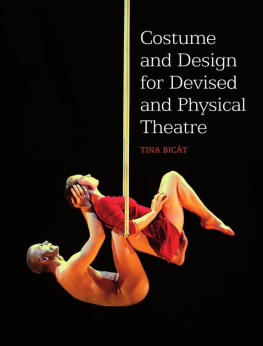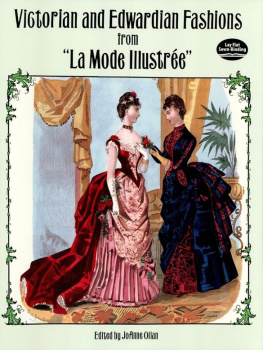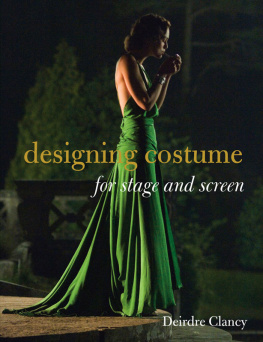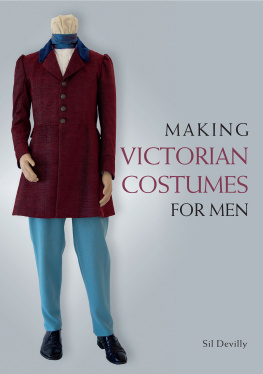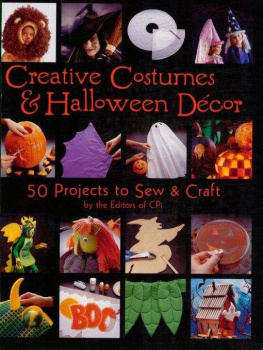Costumes for
the Stage
Costumes for
the Stage
A complete handbook
for every kind of play
Second Edition
by Sheila Jackson

COSTUMES FOR THE STAGE. Copyright 1978 by Sheila Jackson. Revised material copyright 2001 by Sheila Jackson. First New Amsterdam edition published 1988. All rights reserved, including the right to reproduce this book or portions thereof in any form. For information, address: New Amsterdam Books, c/o Ivan R. Dee, Publisher, 1332 North Halsted Street, Chicago, 60622. Manufactured in the United States of America and printed on acid-free paper.
This edition originally published by A & C Black (Publishers) Limited 37 Soho Square, London W1D 3QZ
Library of Congress Cataloging-in-Publication Data:
Jackson, Sheila.
Costumes for the stage : a complete handbook for every kind of play / by Sheila Jackson.--2nd ed.
p. cm.
Includes bibliographical references and index.
ISBN 978-1-56131-068-5 (alk. paper)
1. Costume. I. Title.
PN2067 .J28 2001
792' .026--dc21
2001032563
Contents
Introduction
This book aims at simplicity in all aspects of costume design and making, and involves only processes within the capabilities of the talented amateur or of those already involved in arts and crafts in areas not usually applied to the stage. It is planned so that it can be used with the utmost flexibility and also as a starting point for designers to develop ideas and directions most suited to themselves. I hope that it will encourage an inventive approach to a craft which is an adventure in itself.
The period costumes shown in the drawings are deliberately the simplest versions so that they will be within the scope of the amateur though able person. Occasionally a more elaborate costume is included but is intended only to help set the style of the period. This accounts for what may appear to be omissions, particularly in the tailoring field. If the play requires, for example, nineteenth-century mens evening dress, realistic uniforms or armour, then hiring from a costume rental shop is the most sensible answer to the problem. It will also be considerably cheaper in the long run.
If the performers own hair can be grown, cut or suitably dressed there will be no problems in this department; otherwise it is best to hire wigs too.
The drawings are also intended to lead to fuller research away from the usual costume books on the local library shelves. Old periodicals and journals with pictorial coverage of places and events (such as Punch or Harpers) are an excellent source of both fashionable and social reference. Museums are, of course, a major source of information but quite often interesting details appear in unlikely places, such as an eighteenth-century lady on a clock face or some figures at a picnic on the side of an old cup. Medieval sculptures are a particularly good source of head-dress information. Geographical books and magazines have not only regional information but very often historical reference too. Collect museum postcards, old family photographs and pictures cut from all possible sources and keep them by you and look at them. Reference is to be lived with, not tucked away. Three or four cards pinned where you can see them, and changed from time to time, can often be of more use than many hours spent in museums.
It is difficult to recommend the best way for keeping reference material, because every production requires a different cross-section. Clearly labelled boxes are probably the most versatile method.
When the initial design ideas have been discussed with the director and actors, gather your team and resources around you, take stock of your finances, and start planning. A designer needs a back-up team of a number of people with different capabilities some who are strong on the sewing side and can cut and fit, some who can dye and paint fabrics, and others whose talents lie in trimming and decorating or in using their fingers deftly to make hats, crowns, and jewelry.
The budget will need careful thought. When planning it do not forget the vital though sometimes boring necessities such as shoes, and remember that dyes and sewing materials can become quite a large item.
Last, but by no means least, start work in good time. Staying up all night to get the show on may sound exciting and noble, but mistakes and bad workmanship due to fatigue are the likely result. Bad planning and last minute panic are also expensive, and an early start with plenty of thought will save money, energy and temper.
1 Planning and equipment
Before starting to design and make costumes for a production it is a good idea to plan your work space so that clean work can be kept separate from dyes, paint and glue and all the equipment you will need is within easy reach.
1 An area for clean work: designing, cutting out, sewing, fitting and pressing.
Equipment A cutting table with chairs of suitable height; a strong sewing machine capable of sewing all kinds and thicknesses of material; iron and ironing board; an adjustable light; a dress stand, preferably a small size so that it can be padded as necessary (see drawing); a hat block or head block for working on hats, head-dresses and decorative wigs; yardstick, tape measure, pins, needles, scissors, pinking shears; sewing threads, in a tin box or large glass jar for easy selection; marking chalks and a soft pencil; brown paper or newspaper for making patterns; a stock of tapes, bindings, zippers, hooks and eyes, press studs, buttons, etc. in marked boxes; cardboard boxes large, to hold dress fabrics, and smaller to hold trimmings.
2 An area for messy work painting, gluing, dyeing, cutting and sawing, hammering, etc. A strong, rigid table is essential, and it is useful to have a sink with running water and a gas burner or electric ring within easy reach.
Equipment A zinc bath or bucket for dyeing; a kettle and an old saucepan; scissors, pliers, hack saw, coarse cheese grater (for breaking down fabrics), Stanley (matt) knife and blades, hand drill, eyelet punch, ruler; jars, plastic pots and all kinds of container; paint and glue brushes; plastic bags, various sizes: quantities of newspaper; a small stapling machine; some kind of protective screen for use when spraying paint, etc. On a convenient shelf, in carefully labelled bottles or boxes, keep white spirit (turps substitute), methylated spirit (denatured alcohol), shellac, dyes; gummed paper tape; adhesives; cold water paste; galvanized wire and fuse wire; carpet thread and needles.
Do not throw away plastic containers of any shape or size, old sponges, egg boxes, corrugated cardboard, cardboard tubes, rope and string of various kinds, odd pieces of timber and hardboard (masonite), beads, buttons, buckles and belts, corks, bottle caps, cotton reels. Train yourself to recognize the potentialities of all kind of waste material.
Collect the nucleus of a basic wardrobe Use old trunks, hampers, suitcases or large boxes and tea chests to store cast-off leotards, sweaters, blouses and shirts, pyjama trousers, simple swimming costumes and trunks, bikinis, tights and socks, felt and straw hats. Boots, shoes and other footwear should be kept in a separate box. Collect cast-off fur and fur-fabric coats for trimmings; old sheets, blankets, tablecloths, curtains, bedspreads etc. for cutting into. Store in plastic sacks any old clothes which will come in useful for character costumes or for breaking down into rags. Save old spectacle frames and junk jewelry. If there is space for a hanging rail or rod, this can be used to store costumes from previous productions; an old sheet thrown over it will keep the garments reasonably clean.


